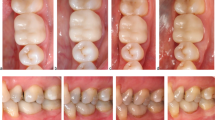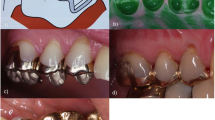Abstract
Cast gold partial crowns (CGPC) are an accepted means of restoring posterior teeth with extended lesions. However, for esthetic reasons, CGPC are being increasingly substituted with partial ceramic crowns (PCC). The aim of the present prospective split-mouth study was to compare the clinical performance of PCC and CGPC. There were 29 patients (male 12, female 17) who participated in the investigation for a total of 58 restorations. In each patient, one CGPC (Degulor C) and one PCC (Vita MarkII/Cerec III) were placed. CGPC were inserted using conventional zinc-phosphate cement (Harvard); PCC were adhesively luted to the cavities (Variolink II/Excite). The restorations were clinically rated using modified United States Public Health Service (USPHS) criteria at baseline and 1 and 2 years after placement. The median patient age was 38 years (range 25–54). There were 29 of the CGPC and 14 PCC placed in molars, while 15 PCC were placed in premolars. All patients were available for the 1- and the 2-year recall. One PCC (1.7%) failed and had to be replaced after 2 years in situ. The rest of the restorations were functional without need of replacement. The evaluation using USPHS criteria revealed no statistically significant differences between CGPC and PCC with the exception of anatomic form: PCC showed occlusal chipping in two cases without need of replacement. From these data, it can be concluded that PCC may provide an esthetic and tissue-conservative alternative to CGPC. However, long-term studies comparing the clinical performance and longevity of cast gold and ceramic partial crowns for posterior teeth are desirable.




Similar content being viewed by others
References
American Dental Association (2003) Acceptance program guidelines: tooth-colored restorative materials for posterior teeth. http://www.ada.org/prof/resources/positions/standards/ denmat.asp#38
Bindl A, Mörmann WH (1997) Chairside-Computer-Kronen-Verfahrenszeit und klinische Qualität. Acta Med Dent Helv 2:293–300
Bindl A, Mörmann WH (2003) Clinical and SEM evaluation of all-ceramic chair-side CAD/CAM generated partial crowns. Eur J Oral Sci 111:163–169
Datzmann G (1996) CEREC Vitablocs Mark II machinable ceramic. In: Mörmann WH (ed) CAD/CIM in aesthetic dentistry. Quintessence, Berlin, pp 205–216
Donly KJ, Jensen ME, Triolo P, Chan D (1999) A clinical comparison of resin inlay and onlay posterior restorations and cast-gold restorations at 7 years. Quintessence Int 30:163–168
Donovan TE, Winston WL (1993) Conservative indirect restorations for posterior teeth - cast versus bonded ceramic. Dent Clin North Am 37:433–443
Felden A, Schmalz G, Federlin M, Hiller KA (1998) Retrospective clinical investigation and survival analysis on ceramic inlays and partial ceramic crowns: results up to 7 years. Clin Oral Investig 2:161–167
Felden A, Schmalz G, Hiller KA (2000) Retrospective clinical study and survival analysis on partial ceramic crowns: results up to 7 years. Clin Oral Investig 4:199–205
Haas M, Arnetzl G, Pertl R, Polansky R, Smetan M (1996) CEREC vs. laboratory inlays. In: Mörmann WH (ed) CAD/CIM in aesthetic dentistry. Quintessence, Berlin, pp 299–312
Isidor F, Brondum K (1995) A clinical evaluation of porcelain inlays. J Prosthet Dent 74:140–144
Karapetian VE, Sorg T, Jöckel V, Baumann MA (1996) Comparison of different polishing systems for dental inlay ceramics. In: Mörmann WH (ed) CAD/CIM in aesthetic dentistry. CEREC 10 year anniversary symposium. Quintessenz, Berlin, pp 553–559
Krämer N, Frankenberger M, Pelka M, Petschelt A (1999) IPS Empress inlays and onlays after four years—a clinical study. J Dent 27:325–331
Krejci I, Krejci D, Lutz F (1992) Clinical evaluation of a new pressed glass ceramic inlay material over 1.5 years. Quintessence Int 23:181–186
Kreulen CM, Creugers NHJ, Meijering AC (1998) Meta-analysis of anterior veneer restorations in clinical studies. J Dent 26:345–353
Martin N, Jedynakiewicz NM (1999) Clinical performance of CEREC ceramic inlays: a systematic review. Dent Mater 15:54–61
Molin M, Karlsson S (1996) A 3-year clinical follow-up study of a ceramic (Optec) inlay system. Acta Odontol Scand 54:145–149
Mörmann WH, Götsch T, Krejci I, Lutz F, Barbakow F (1991) Clinical status of 94 Cerec ceramic inlays after 3 years in situ. In: Mörmann WH (ed) International symposium on computer restorations. The state of the art of the Cerec method (proceedings). Quintessenz, Berlin, pp 355–363
Otto T, De Nisco S (2002) Computer-aided direct ceramic restorations: a 10-year prospective clinical study of CEREC CAD/CAM inlays and onlays. Int J Prosthodont 15:122–128
Pallesen U (1996) Clinical evaluation of CAD/CAM ceramic restorations: 6-year report in CAD/CIM in aesthetic dentistry. In: Mörmann WH (ed) Cerec 10 year anniversary symposium. Quintessenz, Berlin, pp 241–253
Pelka M, Schmidt G, Petschelt A (1996) Klinische Qualitätsbeurteilung von gegossenen Metallinlays und -onlays. Dtsch Zahnärztl Z 51:268–272
Reich E (1997) Befunderhebung und Diagnose. In: Heidemann D (ed) Parodontologie. Urban & Schwarzenberg, München, pp 95–128
Reinelt C, Pelka M, Krämer N, Petschelt A (1995) Inlays and onlays with IPS Empress—clinical performance after 12 months. J Dent Res 74:938 (Abstract 220)
Reiss B, Walther W (2000) Clinical long-term results and 10-year Kaplan–Meier analysis of Cerec restorations. Int J Comput Dent 3:9–23
Roulet JF, Bartsch R, Hickel R (1997) Luting composite wear of glass ceramic inlays after 9 years. J Dent Res 76:163 (Abstract 1197)
Roulet JF, Janda R (2001) Future ceramic systems. Oper Dent 6:211–228
Ryge G (1980) Clinical criteria. Int Dent J 30:347–358
Saxer UP, Mühlemann HR (1975) Motivation und Aufklärung. Schweiz Monatsschr Zahnmed 85:905–919
Schlösser R, Kerschbaum T, Ahrens FJ, Cramer M (1993) Überlebensrate von Teil- und Vollguβkronen. Dtsch Zahnärztl Z 48:696–698
Schmalz G (2004) Komposit-Kunststoffe. In: Schmalz G, Arenholt-Bindslev D (eds) Biokompatibilität zahnärztlicher Werkstoffe. Urban & Fischer, München, pp 100–133
Schmalz G, Geurtsen W (2001) Keramik-Inlays und -Veneers. Dtsch Zahnärztl Z 56:347–348
Schmalz G, Stanley H (2004) Zemente und Keramiken. In: Schmalz G, Arenholt-Bindslev D (eds) Biokompatibilität zahnärztlicher Werkstoffe. Urban & Fischer, München, pp 134–181
Sjogren G, Molin M, van Dijken JW (2004) A 10-year prospective evaluation of CAD/CAM-manufactured (CEREC) ceramic inlays cemented with a chemically cured or dual-cured resin composite. Int J Prosthodont 17:241–246
Stoll R, Sieweke M, Pieper K, Stachniss V, Schulte A (1999) Longevity of cast gold inlays and partial crowns—a retrospective study at a dental school clinic. Clin Oral Investig 3:100–104
Studer SP, Lehner C, Brodbeck U, Schärer P (1996) Short-term results of IPS-Empress inlays and onlays. J Prosthodont 5:277–287
Studer SP, Wettstein F, Lehner C, Zullo TG, Schärer P (2000) Long-term survival estimates of cast gold inlays and onlays with their analysis of failures. J Oral Rehabil 27:461–472
Tobi H, Kreulen CM, Gruythuysen RJ, van Amerongen WE (1998) The analysis of restoration survival data in split-mouth designs. J Dent 26:293–298
van Dijken JW, Hasselrot L, Örmin A, Olofsson AL (2001) Restorations with extensive dentin/enamel-bonded ceramic coverage. A 5-year follow-up. Eur J Oral Sci 109:222–229
Wagner J, Hiller KA, Schmalz G (2003) Long-term clinical performance and longevity of gold alloy vs ceramic partial crowns. Clin Oral Investig 7:80–85
Acknowledgements
The present study was supported in part by Sirona (Bensheim, Germany) and Vita (Bad Säckingen, Germany). The authors are grateful to Prof. Dr. L. J. Nunez, Memphis, Tennessee, for his constructive criticism and for his advice concerning the manuscript.
Author information
Authors and Affiliations
Corresponding author
Rights and permissions
About this article
Cite this article
Federlin, M., Männer, T., Hiller, KA. et al. Two-year clinical performance of cast gold vs ceramic partial crowns. Clin Oral Invest 10, 126–133 (2006). https://doi.org/10.1007/s00784-006-0042-7
Received:
Accepted:
Published:
Issue Date:
DOI: https://doi.org/10.1007/s00784-006-0042-7




